Rice production growth slows despite rising demand
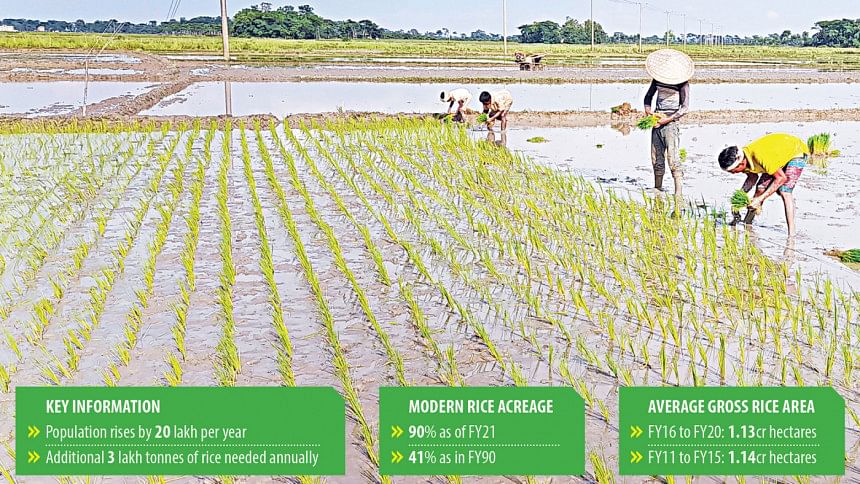
The rice production growth in Bangladesh is slowing as the room for a further expansion of modern high-yielding varieties (HYVs) has squeezed amid reducing cropped area and growing use of agricultural land for non-farm purposes.
Average gross rice cultivated area declined to 1.13 crore hectares in the five years to the fiscal year of 2019-20 from 1.14 crore hectares in the previous five years, data from the Bangladesh Bureau of Statistics (BBS) showed.
Rice production growth decelerated sharply from 0.37 per cent in 2010-11 to 2014-15 to 0.11 per cent in 2015-16 to 2019-20, according to Quazi Shahabuddin, a former director-general of the Bangladesh Institute of Development Studies.
The falling average rice production comes at a time when cultivable land is declining and nearly 20 lakh people are joining the existing population every year. The additional mouths will require an extra 3 lakh tonnes of rice annually.
The fertility of land and water availability is also falling and climate change is threatening farming.
The area under HYVs expanded significantly since Bangladesh's independence as they replaced the local varieties of the staple food.
The modern varieties, which were introduced as part of the Green Revolution, covered 15 per cent of the total area dedicated to producing rice in 1970, according to a book, Bangladesher Orthainaitik Unnayaner Gatidhara published in March. Shahabuddin is a co-author of the book.
The gross rice cultivated area under HYVs and hybrid grew to 90 per cent in 2020-21.
HYVs cover 90 per cent of the rice area during the Boro cultivation, the largest rice crop in Bangladesh, while the improved varieties account for 80 per cent of the total Aman rice, the rain-fed crop, the second largest.
But Shahabuddin thinks the scope for a faster increase in production is low given the current situation.
"The first phase of the Green Revolution is over. We need to increase productivity," he said.
According to Shahabuddin, the reduction in yield gap between farm level and ideal condition would increase rice output.
"Even if we can increase output by one tonne per hectare, the total production will go up by several million tonnes," he said.
However, overall per capita consumption will drop because of growing income and changing lifestyles. Still, the ongoing population growth will create demand for an additional amount of the grain.
In its "Rice Vision for Bangladesh: 2050 and Beyond", the Bangladesh Rice Research Institute (BRRI) said the country acquired a rice surplus of about 20 lakh tonnes in 2014-15.
The state-run organisation is, however, aware that maintaining the current surplus of rice in the coming decades would be a great challenge.
This is because Bangladesh's population would be around 21.15 crore in 2050 when more than 4 crore tonnes of clean rice will be needed to feed them.
The Bangladesh Agricultural Research Council (BARC), in a study, also projected demand of more than 4 crore tonnes of rice in 2050.
The country may face a 36 lakh tonnes of rice deficit by 2030, it said.
The BRRI's Rice Vision cited the hurdles such as decreasing resources and increasing climate vulnerability.
It proposed three major interventions -- accelerating genetic gain, minimising yield gap and curtailing adoption lag -- to break the barriers to achieving the target.
Major challenges to implementing the interventions include shrinking net cropped areas, scarcity of water for irrigation, and increasing pressure on soil fertility.
It suggests measures such as guaranteeing a minimum amount of the net cropped area, accelerating the rate of genetic gain in varietal development, and intensifying collaboration among the stakeholders in order to reduce the adoption lag of newly released promising varieties and achieve the Rice Vision.
The BRRI paper said the yield gap is 20.7 per cent between the actual farm yield and the potential farm yield. If this yield gap could be narrowed by 1.13 per cent annually, there would be 48 million tonnes of surplus rice in 2050.
The average time to reach the adoption peak of the promising varieties released by the BRRI is about 16 years.
And results show that curtailing the adoption lag by five years and 10 years will result in clean rice surplus of 21 lakh tonnes and 43 lakh tonnes in 2050, respectively.
"We are thinking of how we can bring further momentum. We are working on it," said BRRI Director General Md Shahjahan Kabir.
The BRRI has focused on developing a good HYV to replace some benchmark varieties, namely BRRI Dhan-28, BRRI Dhan-29, BR-11, and BRRI Dhan-49.
"We have developed a number of modern varieties so that farmers start growing the new ones instead of the BRRI Dhan-28 during the Boro season," Kabir said.
Similarly, the BRRI has brought in new improved rice varieties for three other popular varieties among farmers for cultivation during the Boro and Aman cultivation seasons.
The yield potential of the new seeds is up to one tonne per hectare, which is higher than BRRI Dhan-28 and 29.
The National Rice Breeding Institute has focused on bringing fallow land, particularly in the southern part of the country, under the Boro cultivation, said Kabir.
Md Shahidur Rashid Bhuiyan, vice-chancellor of Sher-e-Bangla Agricultural University in Dhaka, urges the government to raise investment in agricultural research.
"Serious incentives for agricultural research are necessary. More researchers should be hired for agricultural research to face future challenges."
A professor at the of Genetics and Plant Breeding, Bhuiyan also called for taking the best varieties to the growers quickly instead of focusing on developing new varieties every year.

 For all latest news, follow The Daily Star's Google News channel.
For all latest news, follow The Daily Star's Google News channel. 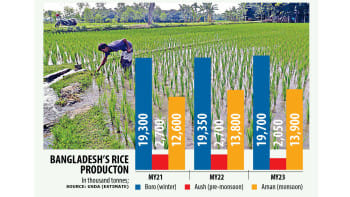






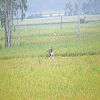
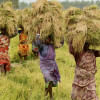

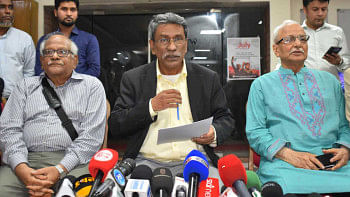
Comments